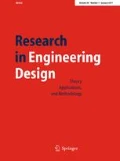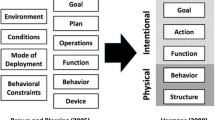Abstract
After reviewing current approaches to design theory, which are based on the transformative concept of function, we argue that this basis in function limits the scope of design problems and explanatory power of current design theories. As an alternative with greater potential for explanatory power and a framework for solving a wider array of design problems, we propose that a relational theory of design is needed. Such a relational theory should mirror those currently developed in mathematics, physics, computer science, and even philosophy. We develop a relational theory for design based on the concept of affordances from perceptual psychology. Affordances help to explain the entanglement between designers, users, and artifacts—relationships that are not currently handled by function based approaches to design. Affordance based design, as developed in this paper, does not offer a radical new approach to doing design, but rather a shift in design thinking. Our focus in this paper is therefore on the explanatory power and potential innovation fostered by this change in design thinking, as illustrated through several examples, and not on specific methods.



Similar content being viewed by others
References
Akiyama K (1991) Function analysis: systematic improvement of quality and performance. Productivity Press, Cambridge
Bertalanffy Lv (1969) General systems theory: foundations, developments, applications, rev edn. George Braziller, New York
Bingham GP (2000) Events (like objects) are things, can have affordance properties, and can be perceived. Ecol Psychol 12(1):29–36. doi:10.1207/S15326969ECO1201_2
Bush DJ (1989) Body icons and product semantics. In: Vihma S (ed) Semantic visions in design: Proceedings from the Symposium on Design Research and Semiotics. 17–18 May, 1989, University of Industrial Arts, Helsinki
Brown DC, Blessing L (2005) the relationship between function and affordance. In: Proceedings of ASME Design Theory and Methodology Conference, Longview, CA. Paper no. DETC2005-85017
Chandrasekaran B, Josephson JR (2000) Function in device representation. Eng Comput 16:162–177. doi:10.1007/s003660070003
Dennett DC, Haugeland J (1987) Intentionality. In: Gregory RL (ed) The Oxford companion to the mind. Oxford University Press, New York
Dixon JR (1966) Engineering design: inventiveness, analysis, and decision making. McGraw-Hill, New York
Flach JM, Hancock PA, Caird JK, Vicente K (eds) (1995) The ecology of human–machine systems. Lawrence Earlbaum, Hillsdale
Forrester JW (1968) Principles of systems. Pegasus Communications
Gaffney ES, Maier JRA, Fadel GM (2007) Roles of function and affordance in the evolution of artifacts. In: Proceedings of ICED’07, Paris, France. 27–30 August, 2007. Paper no. 592
Galvao AB (2007) Design relationships: integrating user information into product development. VDM Verlag, New York
Galvao AB, Sato K (2005) Affordances in product architecture: linking technical functions and user requirements. In: Proceedings of ASME Design Theory and Methodology Conference, Long Beach, CA. Paper no. DETC2005-84525
Galvao AB, Sato K (2006) Incorporating affordances into product architecture: methodology and case study. In: Proceedings of ASME Design Theory and Methodology Conference, Philadelphia, PA. Paper no. DETC2006-99404
Gaver WW (1991) Technology affordances. In: Proceedings of CHI’91. New Orleans, LA, 28 April–2 May, 1991. ACM, New York, pp 79–84
Gell-Mann M (1994) Complex adaptive systems. In: Cowan GA, Pines D, Meltzer D (eds) Complexity: metaphors, models, and reality. Addison-Wesley, New York, pp 17–29
Gibson JJ (1979) The theory of affordances. In: The ecological approach to visual perception. Houghton Mifflin, Hopewell, pp 127–143
Gibson EJ (2000a) Perceptual learning in development: some basic concepts. Ecol Psychol 12(4):295–302. doi:10.1207/S15326969ECO1204_04
Gibson EJ (2000b) Where is the information for affordances? Ecol Psychol 12(1):53–56. doi:10.1207/S15326969ECO1201_5
Gödel K (1931) Metamathematics. van Nostrand, New York
Guralnik DB (ed) (1984) Webster’s New World Dictionary. Warner Books, New York
Hartson HR (2003) Cognitive, sensory, and functional affordances in interaction design. Behav Inf Technol 22(5):315–338. doi:10.1080/01449290310001592587
Hazelrigg GA (1996) Systems engineering: an approach to information-based design. Prentice Hall, Upper Saddle River
Heft H (1989) Affordances and the body: an intentional analysis of Gibson’s ecological approach to visual perception. J Theor Soc Behav 19:1–30. doi:10.1111/j.1468-5914.1989.tb00133.x
Hirtz JM, Stone RB, McAdams DA, Szykman S, Wood K (2001) Evolving a functional basis for engineering design. In: Proceedings of ASME Design Theory and Methodology Conference, Pittsburgh, PA. Paper no. DETC2001/DTM-21688
Hirtz JM, Stone RB, McAdams DA, Szykman S, Wood K (2002) A functional basis for engineering design: reconciling and evolving previous efforts. Res Eng Des 13:65–82. doi:10.1007/s00163-001-0008-3
Jensen T (2000) Function integration explained by allocation and activation of wirk elements. In: Proceedings of ASME Design Theory and Methodology Conference, Baltimore, MD. Paper no. DETC2000/DTM-14551
Kim YS, et al (2007) Affordances in interior design: a case study of affordances in interior design of conference room using enhanced function and task interaction. In: Proceedings of ASME Design Theory and Methodology Conference, Las Vegas, NV. Paper no. DETC2007-35864
Koffka K (1935) Principles of Gestalt psychology. Harcourt Brace, New York
Krampen M (1995) Semiotics in architecture and industrial/product design. In: Margolin V, Buchanan R (eds) The idea of design. MIT Press, Cambridge, pp 89–103
Krippendorff K (1989) Product semantics: a triangulation and four design theories. In: Vakeva S (ed) Product Semantics ‘89: Proceedings from the Product Semantics ‘89 Conference. 16–19 May, 1989, University of Industrial Arts, Helsinki, pp a1–a23
Krippendorff K (1995) On the essential contexts of artifacts or on the proposition that ‘Design is Making Sense (of Things)’. In: Margolin V, Buchanan R (eds) The idea of design. MIT Press, Cambridge, pp 156–184
Kuhn TS (1996) The structure of scientific revolutions, 3rd edn. University of Chicago Press, Chicago
Lintern G (2000) An affordance-based perspective on human–machine interface design. Ecol Psychol 12(1):65–69. doi:10.1207/S15326969ECO1201_7
Maier JRA (2005) Foundations of affordance based design. Ph.D. Dissertation, Department of Mechanical Engineering, Clemson University, Clemson, SC, 29634
Maier JRA, Fadel GM (2001) Affordance: the fundamental concept in engineering design. In: Proceedings of ASME Design Theory and Methodology Conference, Pittsburgh, PA. Paper no. DETC2001/DTM-21700
Maier JRA, Fadel GM (2002) Comparing function and affordance as bases for design. In: Proceedings of ASME Design Theory and Methodology Conference, Montreal, Canada. Paper no. DETC2002/DTM-34029
Maier JRA, Fadel GM (2003) Affordance-based methods for design. In: Proceedings of ASME Design Theory and Methodology Conference, Chicago, IL. Paper no. DETC2003/DTM-48673
Maier JRA, Fadel GM (2005) A case study contrasting german systematic engineering design with affordance based design. In: Proceedings of ASME Design Theory and Methodology Conference, Long Beach, CA. Paper no. DETC2005-84954
Maier JRA, Fadel GM (2006) Understanding the complexity of design. In: Braha D, Minai A, Bar-Yam Y (eds) Complex engineered systems: science meets technology. Springer, Berlin
Maier JRA, Fadel GM (2007) Identifying Affordances. Proceedings of ICED’07, Paris, France. August 27–30, 2007. Paper no. 591
Maier JRA, Ezhilan T, Fadel GM (2007) The affordance structure matrix—a concept exploration and attention directing tool for affordance based design. In: Proceedings of ASME Design Theory and Methodology Conference, Las Vegas, NV. Paper no. DETC2007-34526
Maier JRA, Fadel GM, Batisto D (2008) An affordance based approach to architectural theory, design, and practice. Des Stud (submitted)
Mark LS, Baillet JA, Craver KD, Douglas SD, Fox T (1990) What an actor must do in order to perceive the affordance for sitting. Ecol Psychol 2:325–366. doi:10.1207/s15326969eco0204_2
McGrenere J, Ho W (2000) Affordances: clarifying and evolving a concept. In: Proceedings of Graphics Interface 2000. 13–17 May, 2000. Montreal, Quebec, Canada, pp 179–186
Murphy RR (1999) Case studies of applying Gibson’s ecological approach to Mobile robots. IEEE Trans Syst Man Cybern A Syst Hum 29(1):105–111. doi:10.1109/3468.736365
Norman DA (1988) The design of everyday things. Currency Doubleday, New York
Norman DA (1999) Affordances, conventions and design. Interaction 6(3):38–43. ACM Press. doi:10.1145/301153.301168
Otto K, Wood K (2001) Product design: techniques in reverse engineering and new product development. Prentice Hall, Upper Saddle River
Oudejans RRD, Michaels CF, Bakker FC, Dolne M (1996) The relevance of action in perceiving affordances: perception of catchableness of fly balls. J Exp Psychol Hum Percept Perform 22:879–891. doi:10.1037/0096-1523.22.4.879
Pahl G, Beitz W, Feldhusen J, Grote KH (2007) Engineering design: a systematic approach, vol 3. Springer, New York
Pickering J (2000) On the proper treatment of affordance: formality or mutuality. Ecol Psychol 12(1):71–77. doi:10.1207/S15326969ECO1201_8
Pittenger JB (1995) Some assembly required: biased speculations on the future of human factors design. In: Solso RL, Massaro DW (eds) The science of the mind: 2001 and beyond. Oxford, New York
Riccio GE, Stoffregen TA (1988) Affordances as constraints on the control of stance. Hum Mov Sci 7:265–300. doi:10.1016/0167-9457(88)90014-0
Rodenacker WG (1970) Methodisches Konstruieren. Springer, Berlin
Roth K (1986) Modellbildung fur das methodische Konstruieren ohne und mit Rechnerunterstutzung. VDI-Z, Berlin, pp 21–25
Sanders JT (1997) An ontology of affordances. Ecol Psychol 9:97–112. doi:10.1207/s15326969eco0901_4
Senge PM (1990) The fifth discipline: the art and practice of the learning organization. Currency Doubleday, New York
Sheridan JG, Kortuem G (2006) Affordance-based design of physical interfaces for ubiquitous environments. In: Proceedings of Ubiquitous Computing Systems; Third International Symposium, UCS 2006, Seoul, Korea. LNCS 4239, pp 183–199. Springer, Berlin
Simon HA (1996) The sciences of the artificial, vol 3. MIT Press, Cambridge
St. Amant R (1999) User interface affordances in a planning representation. Hum Comput Interact 14(3):317–354. doi:10.1207/S15327051HCI1403_3
Stoffregen TA (2000) Affordances and events. Ecol Psychol 12(1):1–28. doi:10.1207/S15326969ECO1201_1
Suh NP (1990) The principles of design. Oxford University Press, New York
Suh NP (2001) Axiomatic design: advances and applications. Oxford University Press, New York
Turing AM (1959) Can a machine think? Mind 59:236
Turvey MT (1992) Affordances and prospective control: an outline of the ontology. Ecol Psychol 4:173–187. doi:10.1207/s15326969eco0403_3
Ullman DG (2002) The mechanical design process, vol 3. McGraw-Hill, New York
Warell AV (1999) Introducing a use perspective in product design theory and methodology. In: Proceedings of ASME Design Theory and Methodology Conference, Las Vegas, NV. Paper no. DETC/DTM-8782
Warren WH (1984) Perceiving affordances: visual guidance of stair climbing. J Exp Psychol Hum Percept Perform 10:683–703. doi:10.1037/0096-1523.10.5.683
Warren WH (1995) Constructing an Econiche. In: Flach J, Hancock JP, Caird J, Vicente K (eds) Global perspectives on the ecology of human–machine systems. Lawrence Erlbaum Associates, Hillsdale
Wegner P (1997) Why interaction is more powerful than algorithms. Commun ACM 40(5):80–91. doi:10.1145/253769.253801
Wegner P (1998) Interactive foundations of computing. Theor Comput Sci 192(2):315–351. doi:10.1016/S0304-3975(97)00154-0
Vicente K, Rasmussen J (1990) Ecological interface design: theoretical foundations. IEEE Trans Syst Man Cybern 22(4):589–606. doi:10.1109/21.156574
You H, Chen K (2007) Applications of affordance and semantics in product design. Des Stud 28(1):23–38. doi:10.1016/j.destud.2006.07.002
Zebrowitz LA, Collins MA (1997) Accurate social perception at zero acquaintance: the affordances of a Gibsonian approach. Pers Soc Psychol Rev 1:204–233. doi:10.1207/s15327957pspr0103_2
Author information
Authors and Affiliations
Corresponding author
Rights and permissions
About this article
Cite this article
Maier, J.R.A., Fadel, G.M. Affordance based design: a relational theory for design. Res Eng Design 20, 13–27 (2009). https://doi.org/10.1007/s00163-008-0060-3
Received:
Revised:
Accepted:
Published:
Issue Date:
DOI: https://doi.org/10.1007/s00163-008-0060-3




